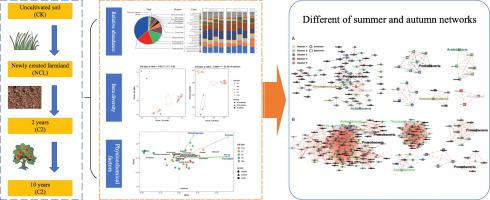Applied Soil Ecology ( IF 4.8 ) Pub Date : 2021-01-06 , DOI: 10.1016/j.apsoil.2020.103853 Fan Chang , Fengan Jia , Rui Lv , Yan Li , Yan Wang , Qingan Jia , Lisha Zhen

|
The effects of microbial succession on soil biological and abiotic variables during agricultural cultivation have been observed. However, little research has explored the changes in microbial communities and their response to newly created farmland, especially on the Loess Plateau. We investigated the changes in soil properties and soil microbial communities during agricultural practice on the Loess Plateau in China using high-throughput sequencing of the 16S rRNA gene. This study analyzed the microbial communities of farmland undergoing agricultural cultivation of raw soil after 2, 5 and 10 years. Acidobacteria, Actinobacteria, Bacteroidetes, Gemmatimonadetes and Proteobacteria were the dominant phyla of soil bacteria across all stages. As the number of years of cultivation increased, the relative abundances of Thaumarchaeota, Chloroflexi, Latescibacteria and Acidobacteria increased gradually, while those of Proteobacteria and Bacteroidetes decreased. Autumn had a significant effect on the microbial alpha diversity indices. The number of years of cultivation greatly affected the community richness. Sucrase, dehydrogenase, active potassium (AK), total nitrogen (TN) and peroxidase were significantly correlated with the abundance of most bacterial groups, indicating the dependence of the bacterial community diversity on the soil nutrient supply. The ecological networks of the biological communities showed that the association among the bacteria differed significantly in different seasons.











































 京公网安备 11010802027423号
京公网安备 11010802027423号